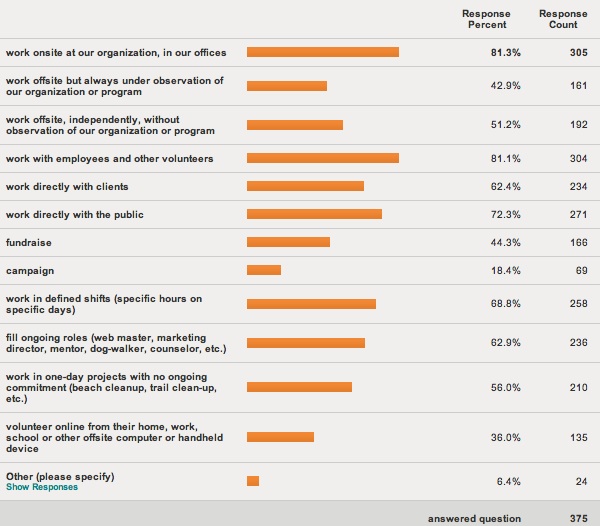On a LinkedIn group, someone asked for a resource to help with volunteer evaluations (forms, policies, etc.). A couple of folks, myself included, responded with some references/resources.
And then came these two comments:
(1)
Volunteers generally do not expect to be evaluated, after all, they are doing the organization a favor.
(2)
As someone who has volunteered in over 30 organizations in a large array of positions, some with intense responsibility, if I had to be vetted each time I volunteered, I would never do any of it. In fact, if I had been appraised, they probably would have disqualified me in the first place when in actuality, I did better than some of their paid and “experienced” staff. It is not worth my time to go through that nonsense, I am a volunteer for goodness sakes. Whenever someone imposes requirements, I just walk away. I have sat on advisory boards of non-profit organizations, as well, and have been entrusted with finances, operations, etc., if they had said you will have to go through some job interview hoops, I would have just laughed and also kept my wallet closed to any further contributions.
Volunteer managers have been working to raise the standards of volunteer involvement schemes for a few decades now, often with success. Yet, there are still oh-so-many entitlement volunteers, those folks who think organizations should take ANY volunteer and whatever that volunteer offers, and simply be grateful for what they get. No standards, no quality control, no performance measurements when it comes to volunteers. To demand quality from volunteers is insulting.
For me, as a volunteer management practitioner and someone who is committed to the success of nonprofit organizations and NGOs, I’m only to happy to show those people the door. I don’t need nor want their services as a volunteer. My organization — and those it serves — deserve better.
Nonprofit organizations are businesses. They aren’t there to be nice, they are there because they are necessary. A nonprofit has a mission — to house stray animals and reduce pet over-population, to present quality, professional theater performances, to educate people about HIV/AIDS, to provide care for victims of domestic violence, to keep a local environment clean, to help family farms survive even the worst economic times, to keep a state park clean and vibrant and accessible, and on and on. For a nonprofit, that mission trumps everything else — including the egos of entitlement volunteers. Nonprofit organizations have very limited resources to meet their mission, and they cannot waste those resources waiting and hoping entitlement volunteers maybe possibly might spare some time this week to staff the information booth at the local fair or come to the board meeting or counsel clients or attend a training or coach a youth soccer team or lead a childcare class or raise the money they have committed to raise or follow the rules.
Let’s say it again: volunteers are not free. An organization has to expend a lot of time and resources to involve volunteers. Organizations have to provide at least one staff member to supervise volunteer work and ensure volunteers don’t do any harm. Staff has to develop activities for volunteers to do — activities that often would be probably be cheaper and done more quickly by staff themselves. The organization has to monitor the volunteers and record their progress to the board and donors. And they must make sure the work volunteers undertake is of the quality and type the organization’s clients deserve.
Therefore, organizations want the people who volunteer to be worth all that investment of time and money. They want volunteers to take their commitment seriously, finish what they’ve started, and continue to support the organization, as volunteers and, maybe, as donors. They don’t want volunteers who aren’t going to show up, who do substandard work, who won’t be on time, who won’t follow policies and procedures, and who will reduce the trust and respect clients, donors and partner organizations have for the organization — those volunteers not only aren’t worth the effort, they aren’t worth the damage they may do.
When I am in charge of recruiting and screening volunteers, I have raised the bar high for applications – and the higher I have raised the bar for new volunteers, the more strict I’ve been regarding standards, the more hoops I’ve required volunteers to jump through with regard to reporting and work quality:
- the less volunteer recruiting I have to do
- the fewer conflicts among and with volunteers I’ve had to deal with
- the fewer volunteers that drop out mid-assignment
- the fewer volunteers I’ve had to let go (in fact, I’ve had to fire a volunteer just once)
- the higher the quality of the volunteers contributions
- the happier volunteers have been (based on their comments and how long they volunteer)
- the less time I spend trying to put together reports showing volunteer effectiveness (because they provide the information automatically; I always have the information on hand, ready when needed)
- the less time I have to spend trying to restore the faith of clients, staff and the general public in the work of the organization, and in volunteers in general, because of volunteer missteps
Nonprofit staff should never be afraid to say no to an offer of volunteer services. They should remember that their organizations and those they serve deserve the very best when it comes to services, including services provided by volunteers. And there are plenty of people out there ready to jump through your hoops and commit to quality volunteer service — and have their own service evaluated.
A version of this blog appeared 11 August 2010
Also see:
Corporate Volunteer Programs: What Do Nonprofits Want From Them?
In defense of skills over passion
No more warm, fuzzy language to talk about volunteers!



